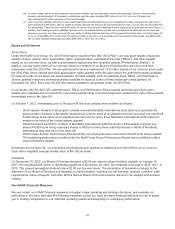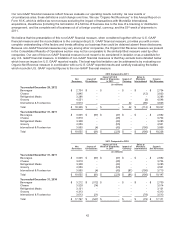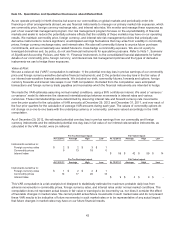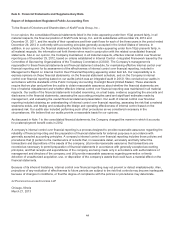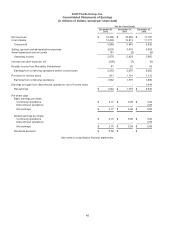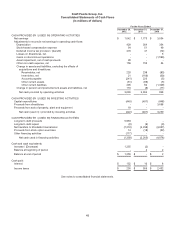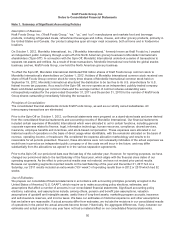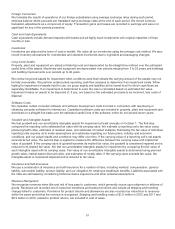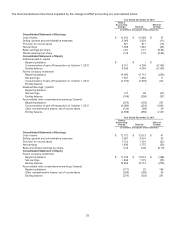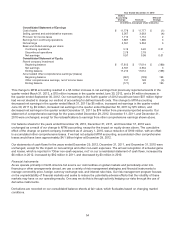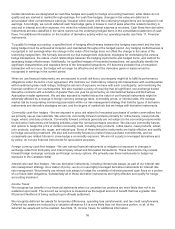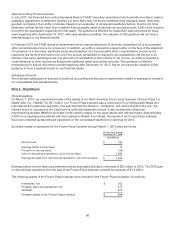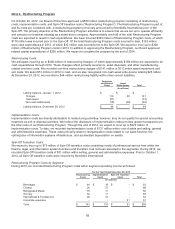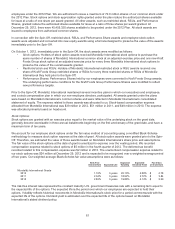Kraft 2012 Annual Report Download - page 53
Download and view the complete annual report
Please find page 53 of the 2012 Kraft annual report below. You can navigate through the pages in the report by either clicking on the pages listed below, or by using the keyword search tool below to find specific information within the annual report.Foreign Currencies:
We translate the results of operations of our foreign subsidiaries using average exchange rates during each period,
whereas balance sheet accounts are translated using exchange rates at the end of each period. We record currency
translation adjustments as a component of equity. Transaction gains and losses are recorded in earnings and were not
significant for any of the periods presented.
Cash and Cash Equivalents:
Cash equivalents include demand deposits with banks and all highly liquid investments with original maturities of three
months or less.
Inventories:
Inventories are stated at the lower of cost or market. We value all our inventories using the average cost method. We also
record inventory allowances for overstocked and obsolete inventories due to ingredient and packaging changes.
Long-Lived Assets:
Property, plant and equipment are stated at historical cost and depreciated by the straight-line method over the estimated
useful lives of the assets. Machinery and equipment are depreciated over periods ranging from 3 to 20 years and buildings
and building improvements over periods up to 40 years.
We review long-lived assets for impairment when conditions exist that indicate the carrying amount of the assets may not
be fully recoverable. We perform undiscounted operating cash flow analyses to determine if an impairment exists. When
testing for impairment of assets held for use, we group assets and liabilities at the lowest level for which cash flows are
separately identifiable. If an impairment is determined to exist, the loss is calculated based on estimated fair value.
Impairment losses on assets to be disposed of, if any, are based on the estimated proceeds to be received, less costs of
disposal.
Software Costs:
We capitalize certain computer software and software development costs incurred in connection with developing or
obtaining computer software for internal use. Capitalized software costs are included in property, plant and equipment and
amortized on a straight-line basis over the estimated useful lives of the software, which do not exceed seven years.
Goodwill and Intangible Assets:
We test goodwill and non-amortizable intangible assets for impairment at least annually on October 1. The first step
compares the reporting unit’s estimated fair value with its carrying value. We estimate a reporting unit’s fair value using
planned growth rates, estimates of residual value, and estimates of market multiples. Estimating the fair value of individual
reporting units requires us to make assumptions and estimates regarding our future plans, industry and economic
conditions, and our actual results and conditions may differ over time. If the carrying value of a reporting unit’s net assets
exceeds its fair value, the second step is applied to measure the difference between the carrying value and implied fair
value of goodwill. If the carrying value of goodwill exceeds its implied fair value, the goodwill is considered impaired and is
reduced to its implied fair value. We test non-amortizable intangible assets for impairment by comparing the fair value of
each intangible asset with its carrying value. Fair value of non-amortizable intangible assets is determined using planned
growth rates, market-based discount rates, and estimates of royalty rates. If the carrying value exceeds fair value, the
intangible asset is considered impaired and is reduced to fair value.
Insurance and Self-Insurance:
We use a combination of insurance and self-insurance for a number of risks, including workers’ compensation, general
liability, automobile liability, product liability, and our obligation for employee healthcare benefits. Liabilities associated with
the risks are estimated by considering historical claims experience and other actuarial assumptions.
Revenue Recognition:
We recognize revenues when title and risk of loss pass to customers, which generally occurs upon shipment or delivery of
goods. Revenues are recorded net of consumer incentives and trade promotions and include all shipping and handling
charges billed to customers. Provisions for product returns and allowances are also recorded as reductions to revenues
within the same period that the revenue is recognized. Shipping and handling costs of $1.0 million in 2012 and 2011 and
$0.9 million in 2010, related to product returns, are included in cost of sales.
51


